How to Start a Successful Blog:The Beginner's Blueprint
Monetizing Your Blog: How to Make Money from Your Passion

Blogging is a popular way to share your thoughts, ideas, and knowledge with the world. It's also a great way to establish yourself as an expert in your niche and build a community of like-minded individuals. Starting a blog may seem daunting, but with the right guidance, it can be a fun and rewarding experience. In this blog post, we will walk you through the steps of how to start a blog.
Choose Your Niche and Blog Name
The first step to starting a blog is to decide on a niche and a blog name. Your niche should be something that you're passionate about and knowledgeable in. It's important to choose a niche that you're genuinely interested in so that you can create content that is valuable to your readers. Once you've decided on your niche, it's time to choose a blog name. Your blog name should be memorable, easy to spell, and related to your niche.
Choosing your niche and blog name is an important first step in starting a blog. Your niche is the specific topic or area that your blog will focus on, and your blog name is the identity that your blog will have. Here are some tips on how to choose your niche and blog name.
Choose Your Niche
Choosing your niche is important because it will determine the type of content you create and the audience you attract. Your niche should be something you're passionate about and knowledgeable in. It should also be something that has an audience, so you can build a community around your blog.
One way to choose your niche is to think about your interests and expertise. What topics do you enjoy learning about? What are your hobbies or passions? What do you have knowledge or experience in? By answering these questions, you can identify areas that you could potentially blog about.
Another way to choose your niche is to research what's popular. Look at other blogs and social media accounts in your areas of interest and see what topics are getting the most engagement. This can help you identify gaps in the market and find a niche that hasn't been fully explored yet.
Choose Your Blog Name
Choosing your blog name is important because it's the identity that your blog will have. Your blog name should be memorable, easy to spell, and related to your niche. Here are some tips on how to choose your blog name.
First, brainstorm ideas. Write down words and phrases related to your niche and see if you can combine them into a catchy and memorable name. Try to come up with a few different options so you can choose the best one.
Next, check if the domain name is available. Your domain name is the website address that people will use to find your blog. Make sure your blog name is available as a domain name, so people can easily find your blog. You can check domain name availability on websites like Hostgator or Namecheap.
Choose a Blogging Platform
Once you've decided on your niche and blog name, it's time to choose a blogging platform. There are several blogging platforms to choose from, including WordPress, Blogger, and Wix. WordPress is the most popular platform, and it's also the most flexible and customizable. It's a great choice for bloggers who want complete control over their blog's design and functionality.
Here are some tips on how to choose a blogging platform.
Consider Your Goals
The first thing to consider when choosing a blogging platform is your goals. What do you want to achieve with your blog? Do you want to build a large audience, monetize your blog, or simply share your thoughts with the world? Different blogging platforms are better suited to different goals, so it's important to choose one that aligns with your goals.
Ease of Use
Another important factor to consider is ease of use. If you're new to blogging, you'll want a platform that's easy to set up and use. Look for a platform that has a user-friendly interface and provides clear instructions on how to get started. Some popular blogging platforms, such as WordPress and Wix, offer drag-and-drop editors that make it easy to create and customize your blog.
Customization Options
Customization is another important factor to consider when choosing a blogging platform. You'll want a platform that allows you to customize the look and feel of your blog to reflect your brand and style. Look for a platform that offers a wide range of templates and themes, as well as the ability to add custom CSS and HTML code.
SEO Features
Search engine optimization (SEO) is important for getting your blog noticed by search engines like Google. Look for a platform that offers built-in SEO features, such as the ability to add meta descriptions and keywords, and clean URLs. WordPress, for example, is known for its strong SEO capabilities.
Monetization Options
If you plan to monetize your blog, you'll want a platform that offers monetization options, such as the ability to display ads or sell products. Some platforms, such as Shopify and Squarespace, offer built-in e-commerce features that make it easy to set up an online store.
Cost
Consider the cost of the platform. Some platforms, such as WordPress and Blogger, are free to use, while others, such as Squarespace and Wix, require a monthly subscription fee. Consider your budget and the features you need when choosing a platform.
Choose a Web Host
After you've chosen your blogging platform, you'll need to choose a web host. A web host is a service that allows your blog to be accessible on the internet. There are several web hosts to choose from, including Bluehost, SiteGround, and HostGator. Bluehost is one of the most popular web hosts and is recommended by WordPress.
After choosing a domain name, selecting a reliable hosting service will be one of the most important decisions you make.
To a great extent, the functionality and performance of your blog will depend on your hosting provider. The host makes sure that your blog is available 24/7 to potential readers and it’s where your content is stored online.
If you are a new blogger, I suggest using HostGator hosting.
Here is why you should be confident going with this company:
Ease-of-use: With Hostgator, you will be able to set up your blog with a few clicks of a button.
Good value: You get reliable service with excellent customer support at an affordable price.
Room to grow: They offer a great set of features that you need to start, run, and grow your blog.
Security: Free SSL certificate included and pre-installed to keep your blog visitors data safe.
Verified provider: Hostgator is a recommended hosting provider on the official WordPress.org website.
Used by many: I personally use their services, and so do many blogger friends and family members.
Survey winner: Based on our research, HostGator is a top choice in the opinion of many blogging experts.
How much does it cost to start a blog?
Below are the costs of a 1-year Hostgator basic hosting plan and what extras you get with it. I was able to negotiate a special deal only for our visitors. Use this link to get an exclusive 73% discount
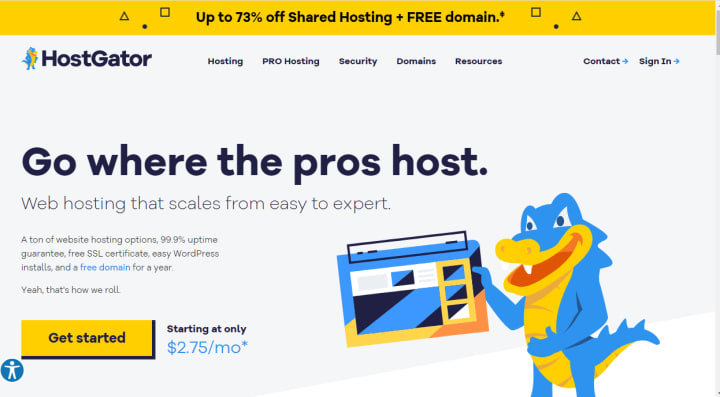
Step 1. Visit the Hostgator homepage
Go to the Hostgator.com website. Then, click the green “Get Started Now” button.
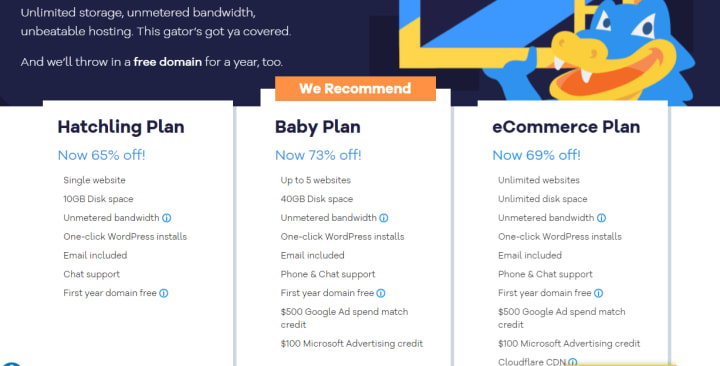
Step 2. Select your hosting plan
You will start by picking a hosting plan. If this is your very first blog, you can go with the Basic plan. Later, you can easily upgrade to a Plus or Choice Plus plan once your blog starts growing. Explore what each plan offers, e.g. Choice Plus plan comes with Domain Privacy and some extras.
Step 3. Set up your domain name
Your domain will be your blog’s address, so you should take your time to come up with something unique and memorable. Just type your desired name into the “new domain” box and Hostgator will show you whether it’s available or not. If not, it will provide you with a list of similar names to choose from.
Don’t worry if you can’t find a good name right away. You can skip this step and pick a name once you start a blog.
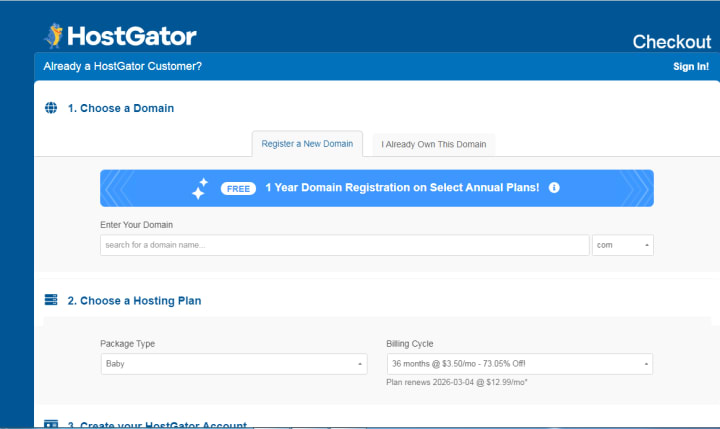
If you have already purchased a domain name somewhere else, you can use that name. Just type it into the “Use a domain you own” box.
Step 4. Register with Hostgator
After you choose your domain, Hostgator will take you to the registration page where you can fill in your personal info manually, or you can Sign in with your Google account to make the process even easier!
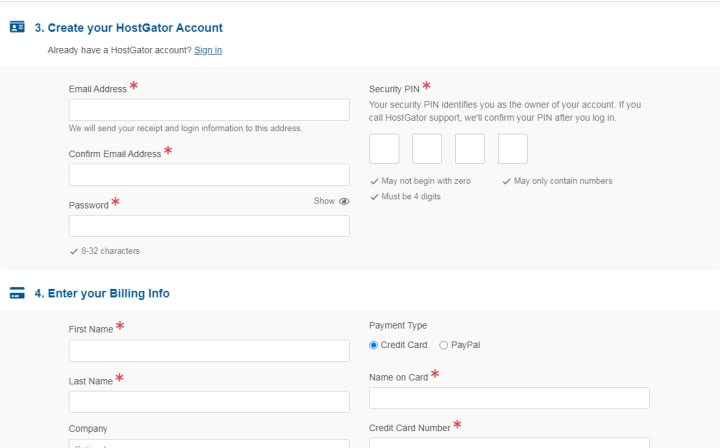
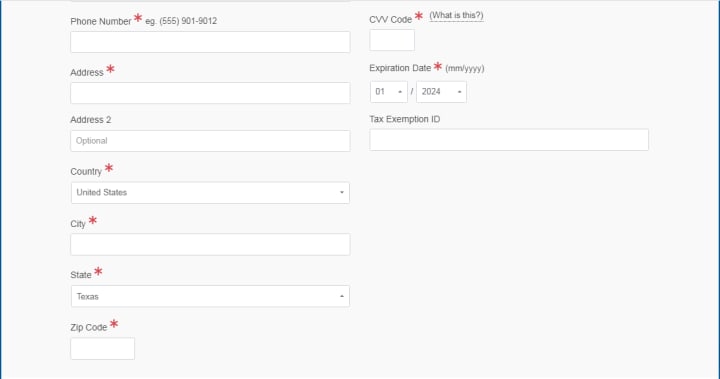
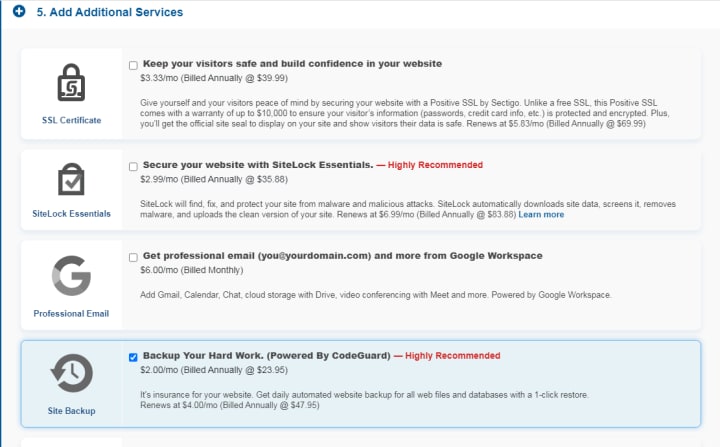
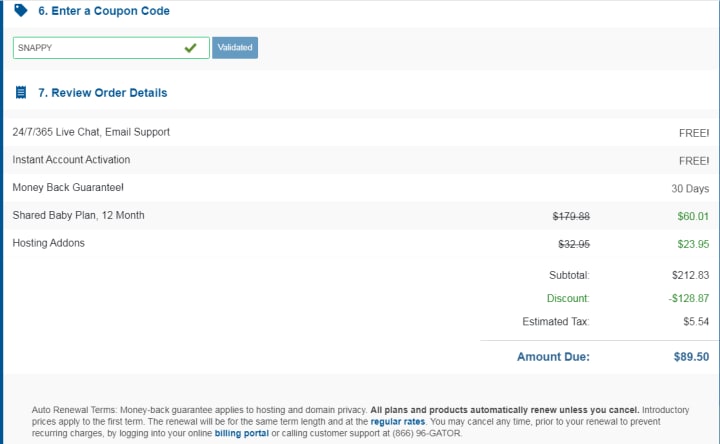
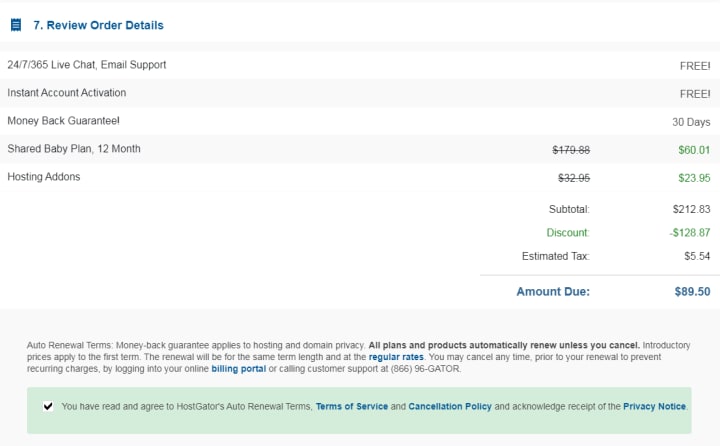
Install WordPress
Once you've chosen your web host, you'll need to install WordPress. Most web hosts offer a one-click WordPress installation, which makes the process quick and easy. If you're not comfortable with installing WordPress, you can hire a professional to do it for you.
Most hosting providers offer a one-click installation process for WordPress. Here are the general steps to install WordPress:
- Log in to your hosting account and navigate to the control panel.
- Look for an option called "WordPress" or "One-Click Install."
- Follow the prompts to install WordPress.
- Once the installation is complete, you'll be given a username and password to log in to the WordPress dashboard.
Choose a Theme
After you've installed WordPress, it's time to choose a theme. Your theme determines how your blog looks and feels. There are thousands of free and premium themes to choose from, and you can customize your theme to suit your needs.
Customize Your Blog
Once you've chosen your theme, it's time to customize your blog. You can customize your blog's header, footer, sidebar, and widgets. You can also add pages, menus, and plugins to your blog. Plugins are tools that add functionality to your blog, such as contact forms, social media sharing buttons, and SEO optimization tools.
Once you've installed WordPress, you can customize your blog to reflect your brand and style. Here are some things you can do to customize your blog:
Choose a theme: WordPress offers thousands of free and premium themes that you can use to customize the look and feel of your blog.
- Install plugins: Plugins are like apps for WordPress. They add functionality to your blog, such as social media sharing buttons or contact forms.
- Create pages: WordPress comes with a few default pages, such as "Home" and "About," but you can create additional pages to showcase your content and information.
- Write your first blog post: Once your blog is set up, it's time to start creating content. Write your first blog post and share it with the world.
Start Creating Content
After you've customized your blog, it's time to start creating content. You should create content that is relevant, informative, and engaging. Your content should be tailored to your niche and should provide value to your readers. You can create blog posts, videos, podcasts, and infographics.
Now that you have chosen your niche, set up your blog, and customized it to your liking, it's time to start creating content. Your blog's content is what will attract readers and keep them coming back for more. In this blog, we'll provide tips on how to start creating content for your blog.
Brainstorm Topics
The first step in creating content is to brainstorm topics. Think about what your target audience would be interested in reading about and create a list of potential topics. You can use tools like Google Trends, Answer the Public, or Quora to get ideas.
Write High-Quality Content
When it comes to blogging, quality is key. Your content should be informative, engaging, and well-written. Write in a conversational tone and use visuals, such as images or videos, to break up the text. Aim to provide value to your readers with each piece of content you publish.

Use Keywords
Keywords are the words and phrases that people use to search for information on the internet. Using keywords in your blog posts can help your content rank higher in search engines, making it easier for people to find your blog. However, be sure to use keywords naturally and avoid "keyword stuffing."
Be Consistent
Consistency is essential when it comes to blogging. Set a schedule for publishing new content and stick to it. This will help you build a loyal audience who knows when to expect new content from you. You can also use tools like a content calendar to plan out your blog posts in advance.
Engage with Your Audience
Engaging with your audience is crucial for building a community around your blog. Respond to comments and emails promptly, and encourage discussion on your blog and social media channels. This will help you build a relationship with your readers and keep them coming back for more.
Experiment with Different Types of Content
Blogging doesn't have to be just about writing articles. Experiment with different types of content, such as infographics, videos, or podcasts. This will help you attract a wider audience and keep your content fresh and exciting.
Promote Your Blog
After you've created content, it's time to promote your blog. You can promote your blog on social media platforms such as Twitter, Facebook, and Instagram. You can also promote your blog through guest posting, email marketing, and search engine optimization (SEO).
Use Social Media
Social media is a powerful tool for promoting your blog. Share your blog posts on your social media channels, such as Facebook, Twitter, LinkedIn, and Instagram. Use hashtags to increase your reach, and engage with your followers to build a community around your blog.
Guest Post on Other Blogs
Guest posting on other blogs is a great way to reach a new audience and gain exposure for your blog. Look for blogs in your niche that accept guest posts and submit a high-quality article. Be sure to include a link back to your blog in your author bio.
Engage in Online Communities
Online communities, such as forums or Facebook groups, can be a great way to connect with others in your niche and promote your blog. Participate in discussions, offer helpful advice, and share your blog posts when relevant. However, be sure to follow the community guidelines and avoid spamming.
Use Email Marketing
Email marketing is a powerful way to promote your blog and connect with your readers. Build an email list by offering a freebie or newsletter subscription, and send out regular emails with your latest blog posts and updates. Be sure to use an eye-catching subject line and include a call-to-action to encourage readers to visit your blog.
Collaborate with Other Bloggers
Collaborating with other bloggers in your niche can help you gain exposure and attract new readers. Consider partnering on a project or hosting a joint webinar or podcast. This will help you tap into each other's audiences and expand your reach.
Analyze Your Performance
Analyzing your blog's performance is essential for improving your content and growing your audience. By tracking key metrics, you can identify what's working and what's not, and make data-driven decisions to optimize your blog's performance. In this blog, we'll provide tips on how to analyze your blog's performance.

Track Your Traffic
One of the most important metrics to track is your blog's traffic. Use tools like Google Analytics to track how many people are visiting your blog, where they're coming from, and which pages they're visiting. This will help you understand your audience and identify which content is most popular.
Monitor Engagement Metrics
Engagement metrics, such as comments, social shares, and time spent on page, are also important to track. These metrics will help you understand how your audience is interacting with your content and whether it's resonating with them. Use tools like Disqus or Facebook comments to track comments, and social media analytics tools to track shares.
Analyze Your Content
Analyzing your content is crucial for improving your blog's performance. Use tools like Google Search Console to identify which keywords your blog is ranking for and which pages are driving the most traffic. Use this data to optimize your content and target keywords that your audience is searching for.
Monitor Your Email List
If you have an email list, be sure to monitor your email marketing metrics, such as open and click-through rates. This will help you understand how your subscribers are interacting with your emails and which types of content they're most interested in.
starting a blog may seem daunting, but it's a fun and rewarding experience. Choose your niche and blog name, choose a blogging platform and web host, install WordPress, choose a theme and customize your blog, create content, promote your
About the Creator
MD Monir Uddin
I’m Monir,I can help you learn how to start a blog,make money through blogging, and get a free guide on how to make money online for beginners.I can provide tips on side hustles,work from home opportunities, blogging, and online work ideas
Enjoyed the story? Support the Creator.
Subscribe for free to receive all their stories in your feed. You could also pledge your support or give them a one-off tip, letting them know you appreciate their work.






Comments
There are no comments for this story
Be the first to respond and start the conversation.